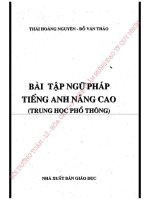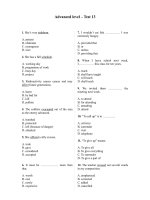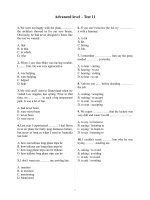Bài giảng ngữ pháp tiếng anh nâng cao (advanced english grammar)
Bạn đang xem bản rút gọn của tài liệu. Xem và tải ngay bản đầy đủ của tài liệu tại đây (6.41 MB, 202 trang )
Ngữ pháp tiếng Anh nâng cao
Advanced English Grammar
Danh mục tài liệu tham khảo của học phần
• Giáo trình chính
1. Randolph Quirk & Sidney Greenbaum (2012), Ngữ pháp tiếng
Anh dành cho sinh viên (A University Grammar of English),
NXB Thời đại
• Tài liệu tham khảo
2. Randolph Quirk & Sidney Greenbaum (2010), A University
Grammar of English _ Workbook, NXB Văn hóa thơng tin
3. />(Elly van Gelderen (2010). An Introduction to the Grammar of
English – Revised edition. John Benjamins Publishing
Company. Amsterdam/ Philadelphia.)
Lecture 1
Introduction
- Introduction to Grammar
- Morphemes and Words
- Parts of speech
- Types of phrases, clauses, sentences
- Parts of a sentence
Issues
1. What is Grammar?
• Traditional concept:
Grammar is a study which consists of 2 groups: morphology and
syntax.
Grammar
Morphology
Parts of speech
(nouns, verbs, adjectives….)
Syntax
Sentences
(simple, complex, compound…)
• New concept:
Grammar is a study of a set of rules.
morphological rules
(parts of speech)
syntactic rules
(phrases, clauses, sentences)
2
Morphemes and Words
discourse
sentence
phrase
word
morpheme
2
Morphemes and Words
discourse
I found
myself
useless.
sentence
I actually felt tired of
sitting doing nothing.
And I hated enjoying
the unemployment
benefit. I found myself
useless. Then I decided
to look or a job.
hated
enjoying
phrase
tired,
job,
myself
word
use,
-less,
morpheme
2
MORPHEME
Morphemes and Words
= A minimal meaningful unit
E.g.: re/try
boy/s
A morpheme can stand alone to make
a word (try, boy) or have to be
attached to another form (re, s).
2
Morphemes and Words
WORD
= An independent meaningful unit.
E.g.: try
boy
turn
return
2
Types of morphemes
Occurrence
Types
Free
(words)
Bound
(affixes)
Grammatical
Function words:
prepositions, pronouns,
conjunctions....
inflectional
(suffixes)
Lexical
Content words:
Nouns, verbs, adverbs,
adjectives
derivational
(prefixes, suffixes)
2. Parts of speech
Parts of speech
Closed system
prepositions,
conjunctions,
articles,
auxiliaries,
interjections,
pronouns
Open class
nouns, verbs,
adjectives,
adverbs
2. Parts of speech
• Number:
• Combination:
• Function:
• Stress:
• The way to
define:
Closed-system items
- limited in number
- exclusively used
- don’t have clear functions
- are often unstressed in
normal speech
- have to compare with other
items or put in speech
- Note: Closed system items=
Functional words
Open-class items (n, v, adj..)
- uncountable in number
- can be used in combination
- have certain syntactic
functions
- are often stressed
- Open-class items = notional
words
Types of phrases, clauses, sentences
Syntax
Phrase
Clause
Sentence
3. Types of phrases
Noun
phrase
pre-modifiers + head noun
+ post-modifiers /
modification
eg: - a beautiful girl in the corner
pre-modifiers + head + post-modifiers
- computer hacker
pre-modifiers + head
Verb
phrase
prehead + head Verb + post
head
eg: is going to buy
prehead + head
- has been waiting for
prehead + head + post head
Adjective adjective + adjectival
phrase complementation
eg: I’m not sure about her condition
adjective + adj C
3. Types of phrases
Prepositional
phrase
Adverb
phrase
preposition +
prepositional
complementation
eg: on the table
preposition + pre C
adverbial
eg: very hard
complementation adverb
adv C + adverb
Practice
How many phrases can you find in the following
sentence?
• She has been working very hard in this
small garden for two hours.
4. Types of clauses
A clause is a part of the sentence that contains a verb. A
typical clause consists of a subject and a predicate, the latter
typically a verb phrase, a verb with any objects and other
modifiers
=> Clauses are the principal structures of which sentences are
composed.
=> A sentence may consist of one, or more than one clause
4. Types of clauses
Syntax
Clause
In terms of Clause’s
elements & verb patterns
In terms of functions of
the clause
In terms of kinds of
verb phrases
4. Types of clauses
4.1. In terms of the verb phrase in the clause:
finite VP
finite clause
non-finite VP
non-finite clause
Verb phrase
4. Types of clauses
- Finite clause (S – V has concord with S in person + number,
Verbs has tense distinction)
- Non-finite clause (with or without Subject, without concord,
without tense distinction)
Practice: How many clauses can you find in the following sentences?
1. I want to become a film star.
2. What I want to say was that he tried to escape from poverty.
3. Indonesian government considered East Timor a mere pebble in the
government shoes.
4. I heard a child crying.
4. Types of clauses
4.2. In terms of the CLAUSE ELEMENTS and the VERB
PATTERNS which are formed from these elements.
u SVA
u SVCs
u SVO
u SVOO
u SVOA
u SVOCo
u SV
4. Types of clauses
Practice:
1.
2.
3.
4.
5.
6.
7.
Identify the types of the following clauses
Mary felt tired.
Mary made him surprised.
Mary was reading a novel.
Mary smiled.
Mary gave him a postcard.
Mary was in the garden.
Mary put the book on the table.
4. Types of clauses
4.3. In terms of the relation with other clauses in a sentence
Clauses can be divided into MAIN CLAUSES and
SUBCLAUSES. Subclauses are those which are part of
another clause.
Subclause
E.g. I think
that you can do it.
Main clause
4. Types of clauses
- Main Clauses = Superordinate CL = independent CL
- Subclauses = Subordinate CL = dependent CL
Eg: Seeing
non-finite
is
believing.
non-finite
finite
What made him more surprised was her behavior.
S
V
C
5. Types of sentences
Syntax
Sentences
E.g.: All these books are mine.
E.g.: He likes singing but he can’t sing very
well.
E.g.: He didn’t want to talk to whoever he met in
the London workshop.
E.g.: Having seldom talked anyone before, the
child simply wide opened his beautiful eyes
and looked at the stranger.
Simple
Compound
Complex
Complex compound









